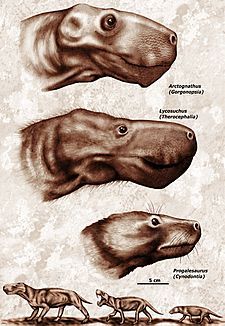Theriodont facts for kids
Quick facts for kids TheriodontsTemporal range: Middle Permian – Lower Cretaceous
265 to 100 million years ago Descendant taxon Mammalia survives to present. |
|
|---|---|
 |
|
| Scientific classification | |
| Kingdom: | |
| Phylum: | |
| Class: | |
| Order: | |
| (unranked): |
Theriodontia
|
| Groups | |
|
|
Theriodonts were a very important group of ancient animals. They were a type of therapsid, which are often called "mammal-like reptiles." Theriodonts are special because they include not only the ancient creatures themselves, but also all their descendants, including modern mammals. This is like how theropod dinosaurs include birds today.
These animals lived a very long time ago. They first appeared about 265 million years ago, during the Middle Permian period. They continued to live until the Middle Cretaceous period. Even the earliest theriodonts looked more like mammals than their other relatives.
Contents
Types of Theriodonts
Theriodonts are divided into three main groups:
Scientists believe that early theriodonts might have been warm-blooded. This means they could control their body temperature, like mammals do today. The first theriodonts were meat-eaters. However, some groups that came later became plant-eaters during the Triassic period.
How Theriodonts Changed Over Time
Theriodonts had jaws that were more like mammal jaws than other therapsids. Their lower jaw, called the dentary, was bigger. This helped them chew their food much better.
Also, some bones that used to be part of the lower jaw moved into their ears. This change helped theriodonts hear better. It also allowed their mouths to open wider. These improvements made theriodonts a very successful group of synapsids.
Eutheriodonts: True Beast Teeth
The term Eutheriodonts refers to all theriodonts except the gorgonopsians. Gorgonopsians were the most ancient or "primitive" group. Eutheriodonts included the therocephalians, cynodonts, and their descendants, the mammals. The name "Eutheriodont" means "true beast tooth."
Eutheriodonts had larger skulls. This meant they had bigger brains. They also had stronger jaw muscles. These features helped them survive and thrive.
Surviving the Great Extinction
The theriodonts (specifically the eutheriodonts) were one of only two groups of synapsids that survived the huge Permian–Triassic extinction event. This event wiped out most life on Earth. The other group that survived was the dicynodonts.
After the extinction, therocephalians included both meat-eaters and plant-eaters. However, both types died out after the early Triassic period.
The Rise of Cynodonts
The remaining theriodonts were the cynodonts. This group included meat-eaters like Cynognathus. It also included new plant-eating groups called Traversodonts.
Most Traversodonts stayed medium to large in size, with some growing up to 2 meters long. But the meat-eating cynodonts became smaller as the Triassic period went on.
By the Late Upper Triassic period, there were small cynodonts like the tritylodonts. These animals looked a bit like rodents. There were also tiny, shrew-like animals called trithelodonts. These trithelodonts eventually evolved into the first mammals.
The trithelodonts died out during the Jurassic period. The tritylodonts survived into the Cretaceous period. But the mammals kept evolving and changing. Many mammal groups even survived the Cretaceous–Tertiary extinction event. This event wiped out the non-avian dinosaurs. Because the dinosaurs were gone, mammals were able to spread out and become the main animals on Earth.
See also
 In Spanish: Theriodontia para niños
In Spanish: Theriodontia para niños


